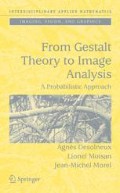The global analysis of digital images can involve the histograms of variables like the gray level or the orientation. Usually histograms are not flat. Peaks and lacunary parts are observed. The peaks can correspond to meaningful groups and the lacunary intervals correspond to separations between them. We will call the peaks modes of the histogram. Lacunary intervals are called gaps. Since their analysis will in essence be symmetric, we will focus on the modes. How can we decide whether a mode or a gap is meaningful or not? This problem is very similar to the alignment detection problem. As in the meaningful alignment theory, the Heimholte principle can be adopted. There is indeed no a priori knowledge about the histogram model. Thus meaningfulness can be computed as though all samples were uniformly and independently distributed. Meaningful modes will be defined as counterexamples to this uniformity assumption and maximal meaningful modes will be the best counterexamples to uniformity. The exclusion principle will be involved again. It will be proven that maximal meaningful modes of the histogram are disjoint. This will give an algorithm that can be immediately applied to image analysis. Can such a detection theory give an account of the so-called “visual pyramid”? According to the visual pyramid doctrine geometric events (gestalts) are grouped recursively at different scales (see Chapter 1). This pyramidal assumption can be confirmed only if the detection of geometric events is robust enough. A first test of visual pyramid (i.e., a combination bottom up of gestalt grouping), is given in the last section. All maximal meaningful alignments of an image will be computed and the obtained segments grouped according to the mode of the orientation histogram to which they belong. This yields an implementation of the parallelism gestalt.
Access this chapter
Tax calculation will be finalised at checkout
Purchases are for personal use only
Preview
Unable to display preview. Download preview PDF.
Rights and permissions
Copyright information
© 2008 Springer
About this chapter
Cite this chapter
(2008). Modes of a Histogram. In: From Gestalt Theory to Image Analysis. Interdisciplinary Applied Mathematics, vol 34. Springer, New York, NY. https://doi.org/10.1007/978-0-387-74378-3_7
Download citation
DOI: https://doi.org/10.1007/978-0-387-74378-3_7
Publisher Name: Springer, New York, NY
Print ISBN: 978-0-387-72635-9
Online ISBN: 978-0-387-74378-3
eBook Packages: Mathematics and StatisticsMathematics and Statistics (R0)

